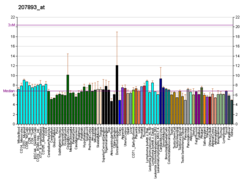
Sex-determining region Y protein (SRY), or testis-determining factor (TDF), is a DNA-binding protein (also known as gene-regulatory protein/transcription factor) encoded by the SRY gene that is responsible for the initiation of male sex determination in therian mammals (placental mammals and marsupials).[5] SRY is an intronless sex-determining gene on the Y chromosome.[6] Mutations in this gene lead to a range of disorders of sex development with varying effects on an individual's phenotype and genotype.
SRY is a member of the SOX (SRY-like box) gene family of DNA-binding proteins. When complexed with the (SF-1) protein, SRY acts as a transcription factor that causes upregulation of other transcription factors, most importantly SOX9.[7] Its expression causes the development of primary sex cords, which later develop into seminiferous tubules. These cords form in the central part of the yet-undifferentiated gonad, turning it into a testis. The now-induced Leydig cells of the testis then start secreting testosterone, while the Sertoli cells produce anti-Müllerian hormone.[8] SRY gene effects normally take place 6–8 weeks after fetus formation which inhibits the female anatomical structural growth in males. It also works towards developing the secondary sexual characteristics of males.
- ^ a b c GRCh38: Ensembl release 89: ENSG00000184895 – Ensembl, May 2017
- ^ a b c GRCm38: Ensembl release 89: ENSMUSG00000069036 – Ensembl, May 2017
- ^ "Human PubMed Reference:". National Center for Biotechnology Information, U.S. National Library of Medicine.
- ^ "Mouse PubMed Reference:". National Center for Biotechnology Information, U.S. National Library of Medicine.
- ^ Berta P, Hawkins JR, Sinclair AH, Taylor A, Griffiths BL, Goodfellow PN, et al. (November 1990). "Genetic evidence equating SRY and the testis-determining factor". Nature. 348 (6300): 448–50. Bibcode:1990Natur.348..448B. doi:10.1038/348448A0. PMID 2247149. S2CID 3336314.
- ^ Wallis MC, Waters PD, Graves JA (October 2008). "Sex determination in mammals--before and after the evolution of SRY". Cellular and Molecular Life Sciences. 65 (20): 3182–95. doi:10.1007/s00018-008-8109-z. PMC 11131626. PMID 18581056. S2CID 31675679.
- ^ Cite error: The named reference
Kashimada_Koopman_2010was invoked but never defined (see the help page). - ^ Mittwoch U (October 1988). "The race to be male". New Scientist. 120 (1635): 38–42.





